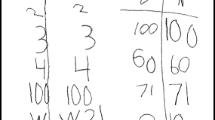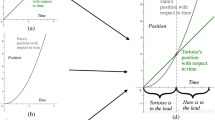Abstract
This paper presents a conceptual analysis for students’ images of graphs and their extension to graphs of two-variable functions. We use the conceptual analysis, based on quantitative and covariational reasoning, to construct a hypothetical learning trajectory (HLT) for how students might generalize their understanding of graphs of one-variable functions to graphs of two-variable functions. To evaluate the viability of this learning trajectory, we use data from two teaching experiments based on tasks intended to support development of the schemes in the HLT. We focus on the schemes that two students developed in these teaching experiments and discuss their relationship to the original HLT. We close by considering the role of covariational reasoning in generalization, consider other ways in which students might come to conceptualize graphs of two-variable functions, and discuss implications for instruction.







Similar content being viewed by others
Notes
We use the term “schemes” to mean well-coordinated, complex structures of individual schema. See Thompson (2013) for expanded discussion of the term.
Here, our description of covariation assumes functions that are continuous over the real numbers.
Note that the notion of a difference function applies widely, not just to polynomial functions. We focus on polynomial functions in this activity because of their familiarity to students.
References
Avitzur, R. (2011). Graphing calculator (version 4.0). Berkeley: Pacific Tech.
Dugdale, S., Wagner, L. J., & Kibbey, D. (1992). Visualizing polynomial functions: New insights from an old method in a new medium. Journal of Computers in Mathematics and Science Teaching, 11(2), 123–142.
Krutetskii, V. A. (1969). An analysis of the individual structure of mathematical abilities in schoolchildren. Soviet Studies in the Psychology of Learning and Teaching Mathematics, 2, 59–104.
Krutetskii, V. A. (1976). The psychology of mathematical ability in schoolchildren (J. Teller, Trans.). Chicago: University of Chicago Press.
Martinez-Planell, R., & Trigueros, M. (2012). Students' understanding of the general notion of a function of two variables. Educational Studies in Mathematics, 81(3), 365–384.
Montiel, M., Vidakovic, D., & Kabael, T. (2008). Relationship between students’ understanding of functions in Cartesian and polar coordinate systems. Investigations in Mathematics Learning, 1(2), 52–70.
Montiel, M., Wilhelmi, M. R., Vidakovic, D., & Elstak, I. (2009). Using the onto-semiotic approach to identify and analyze mathematical meaning when transiting between different coordinate systems in a multivariate context. Educational Studies in Mathematics, 72(2), 139–160.
Oehrtman, M., Carlson, M. P., & Thompson, P. W. (2008). Foundational reasoning abilities that promote coherence in students' understandings of function. In M. P. Carlson & C. Rasmussen (Eds.), Making the connection: Research and practice in undergraduate mathematics (pp. 150–171). Washington, DC: Mathematical Association of America.
Presmeg, N. C. (1986). Visualisation and mathematical giftedness. Educational Studies in Mathematics, 17(3), 297–311.
Presmeg, N. C. (1992). Prototypes, metaphors, metonymies and imaginative rationality in high school mathematics. Educational Studies in Mathematics, 23(6), 595–610.
Presmeg, N. C. (2006). Research on visualization in learning and teaching mathematics. In A. Gutierrez & P. Boero (Eds.), Handbook of research on the psychology of mathematics education: Past, present and future (pp. 205-235). Sense Publishers.
Saldanha, L., & Thompson, P. W. (1998). Re-thinking co-variation from a quantitative perspective: Simultaneous continuous variation. In S. B. Berensah, K. R. Dawkings, M. Blanton, W. N. Coulombe, J. Kolb, K. Norwood & L. Stiff (Eds.), Proceedings of the Twentieth Annual Meeting of the North American Chapter of the International Group for the Psychology of Mathematics Education (Vol. 1, pp. 298-303). Columbus, OH: ERIC Clearninghouse for Science, Mathematics, and Environmental Education.
Smith, J., III, & Thompson, P. W. (2008). Quantitative reasoning and the development of algebraic reasoning. In J. J. Kaput & M. Blanton (Eds.), Algebra in the early grades (pp. 95–132). New York: Lawrence Erlbaum Associates.
Steffe, L. P., & Thompson, P. W. (2000). Teaching experiment methodology: Underlying principles and essential elements. In R. Lesh & A. E. Kelly (Eds.), Research design in mathematics and science education. Mahwah: Lawrence Erlbaum Associates.
Strauss, A. L., & Corbin, J. (1998). Basics of qualitative research: Techniques and procedures for developing grounded theory (2nd ed.). Thousand Oaks: Sage.
Thompson, P. W. (1994). The development of the concept of speed and its relationship to concepts of rate. In G. Harel & J. Confrey (Eds.), The development of multiplicative reasoning in the learning of mathematics (pp. 179–234). Albany: SUNY Press.
Thompson, P. W. (2008). Conceptual analysis of mathematical ideas: Some spadework at the foundation of mathematics education. In O. Figueras, J. L. Cortina, S. Alatorre, T. Rojano & A. Sepulveda (Eds.), Proceedings of the 32nd annual conference of the International Group for the Psychology of Mathematics Education (Vol. 4, pp. 45-64). Morelia, Mexico: PME.
Thompson, P. W. (2011). Quantitative reasoning and mathematical modeling. In L. L. Hatfield, S. Chamberlain, & S. Belbase (Eds.), New perspectives and directions for collaborative research in mathematics education (pp. 33–57). Laramie: University of Wyoming.
Thompson, P. W. (2013). In the absence of meaning. In K. Leatham (Ed.), Vital directions for research in mathematics education (pp. 57–93). New York: Springer.
Trigueros, M., & Martinez-Planell, R. (2010). Geometrical representations in the learning of two-variable functions. Educational Studies in Mathematics, 73, 3–19.
Weber, E., & Dorko, A. (2014). Students’ and experts’ schemes for rate of change and its representations. Journal of Mathematical Behavior. doi:10.1016/j.jmathb.2014.01.002.
Yerushalmy, M. (1997). Designing representations: Reasoning about functions of two variables. Journal for Research in Mathematics Education, 28(4), 431–466.
Acknowledgments
This research was supported by National Science Foundation (NSF) Grant No. MSP-1050595. Any recommendations or conclusions stated here are of the authors and do not necessarily reflect official positions of the NSF. Any recommendations or conclusions stated here are of the authors and do not necessarily reflect official positions of the NSF.
Author information
Authors and Affiliations
Corresponding author
Rights and permissions
About this article
Cite this article
Weber, E., Thompson, P.W. Students’ images of two-variable functions and their graphs. Educ Stud Math 87, 67–85 (2014). https://doi.org/10.1007/s10649-014-9548-0
Published:
Issue Date:
DOI: https://doi.org/10.1007/s10649-014-9548-0




